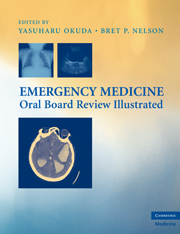Book contents
- Frontmatter
- Contents
- Contributors
- 1 How to Use This Book
- 2 EM Medical Decision Making
- 3 About the Oral Boards: The Approach and Practical Tips
- CASES
- Appendix A The Chest Pain Patient: Five Life-Threatening Causes and Critical Actions
- Appendix B The Confused Patient: Ten Most Common Causes and Critical Actions
- Appendix C The Poisoned Patient: Most Common Toxidromes and Treatments
- Appendix D The Trauma Patient: The Approach and Important Principles
- Appendix E Advanced Cardiac Life Support Review
- Appendix F Pediatric Pearls: High-Yield Facts from Fever to Drugs
- Appendix G Twenty Common Emergency Medicine Procedures: Indications, Contraindications, Technique, and Complications
- Appendix H Image Answer Key
- Index
- Plate section
3 - About the Oral Boards: The Approach and Practical Tips
Published online by Cambridge University Press: 04 August 2010
- Frontmatter
- Contents
- Contributors
- 1 How to Use This Book
- 2 EM Medical Decision Making
- 3 About the Oral Boards: The Approach and Practical Tips
- CASES
- Appendix A The Chest Pain Patient: Five Life-Threatening Causes and Critical Actions
- Appendix B The Confused Patient: Ten Most Common Causes and Critical Actions
- Appendix C The Poisoned Patient: Most Common Toxidromes and Treatments
- Appendix D The Trauma Patient: The Approach and Important Principles
- Appendix E Advanced Cardiac Life Support Review
- Appendix F Pediatric Pearls: High-Yield Facts from Fever to Drugs
- Appendix G Twenty Common Emergency Medicine Procedures: Indications, Contraindications, Technique, and Complications
- Appendix H Image Answer Key
- Index
- Plate section
Summary
Emergency medicine (EM) is rich in what is known as narrative medicine. Stories are the foundation of our practice. Patients tell us their stories. We edit them and add in our own details (test results, radiography, etc). We often retell these stories: if we are students to attending physicians during clinical rotations; if we are attendings or residents to colleagues and consultants when we seek input into a complex case; and even back to patients when we have solved the case, or at least written the next chapter.
It is wholly appropriate that the American Board of Emergency Medicine (ABEM) incorporates an oral examination into its certification process. As a process the ABEM oral examination involves elements of an Observed Structured Clinical Encounter (OSCE) and simulation, though it does not incorporate high-fidelity simulation (yet). As with an OSCE the process must be organized and thorough because it is observed and scored. Like a simulated patient it evolves in a version of “real time” in which decisions and commitment to certain pathways must be made. You must interact with the examiner as if you are speaking to a real patient, a real family member, a real consultant, or other real staff.
The oral board examination “stories” actually unfold in hotel bedrooms. The exam is given at the Chicago Marriott O'Hare Airport Hotel. The cases are administered within the guest rooms along a long hallway. It is important to know this upfront so months of preparation are not undone by surprise at the setting.
- Type
- Chapter
- Information
- Emergency Medicine Oral Board Review Illustrated , pp. 19 - 26Publisher: Cambridge University PressPrint publication year: 2009



